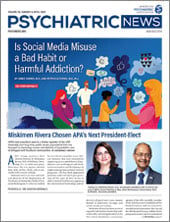In his studies of treatment-refractory and high-utilizing medical patients, Michael Balint (who gave us the concept of patient centeredness) advocated for primary care providers to develop skills for “
six-minute psychotherapy” to address psychological factors undermining good outcomes. At the time, he could not have imagined that psychiatrists would need encouragement to use psychotherapy skills or to feel authorized to use those skills with complex and treatment-refractory patients in pharmacotherapy.
To effectively treat many treatment-resistant patients, the psychiatrist often has to understand psychological factors undermining treatment. This requires an “overall diagnosis” that includes inquiry into the patient’s unconscious, relational patterns, and wishes for treatment, according to
a 1967 paper by Enid Balint in
The Journal of the College of General Practitioners. Once understood, skills for a kind of “ordinary medical psychotherapy” may address factors undermining the healthy use of medications.
Which psychotherapeutic skills are relevant in this context? In a
2006 paper in
Clinical Psychology, Matthew D. Blagys and Mark J. Hilsenroth identified seven practices that were distinct to and characteristic of psychodynamic psychotherapy, all of which have potential applications in routine pharmacotherapy with complex patients.
•
Emphasis on past experiences
•
Identification of patterns
•
Focus on interpersonal experiences
•
Emphasis on the therapeutic relationship
•
Exploration of patients’ wishes and/or fantasies
Such practices can help reorient patients to a healthier use of treatment. The main difference between such “ordinary medical psychotherapy” and psychotherapy proper is that our psychotherapeutic skills, in this case, are not intended to help patients develop insight in a general sense, but rather to support optimal pharmacotherapy.
Focus on affect: In pharmacotherapy, attending to subtle affective shifts, using skills honed in psychotherapy, may illuminate unspoken ambivalence about treatment, as when patients agree to a medication, but then their foot starts anxiously tapping. Such attunement to affect helps to bring sources of resistance to treatment into awareness where they can be addressed rather than be left to be acted out.
Further, many patients may conflate “problems of living” with “problems of illness” (and perhaps not just our patients, but ourselves, too). Patients who have a medicalized understanding of their emotions may need help to understand that bad feelings are not always signs of pathology, but rather signals that there are problems that need to be addressed. By helping patients to recognize the signal function of affects, doctor and patient together can grapple to understand which types of suffering require medication and which are better addressed at a psychosocial level.
Exploration of patients’ avoidance: One common form that avoidance may take in pharmacotherapy is the avoidance of meaning. Given a complex interplay between meaning and medication, an insistence on the part of patients that their problems are simply biological may raise suspicions that there are aspects of meaning (for example, feelings of guilt, responsibility, or blame) that are being avoided. Paradoxically, patients who are most attached to a biomedically reductionist understanding of their troubles may be those who are most in need of psychotherapy.
Emphasis on past experiences: To better understand factors undermining the healthy use of medications, the psychodynamically informed psychopharmacologist may explore patients’ early developmental experiences with caregiving, as transference-based expectations may interfere with a good working alliance. Complicated reactions to medications may be transmitted transgenerationally, so an emphasis on past experiences with medications might also include an exploration of family or cultural experiences with treatment as well as more recent experiences with treatment and medications.
Identification of patterns: Practicing integratively, a pharmacotherapist may explore a patient’s life patterns to identify potential sources of resistance to medications or psychiatric caregivers. For example, a patient who struggles to form stable relationships because of a need for control may experience problems with medicine adherence, as the patient may refuse to be controlled by the doctor’s prescription. Emphasizing the psychiatrist’s authority or expertise will backfire in promoting adherence. To help identify treatment-interfering patterns, it is useful to inquire about the patient’s historical patterns of medication use. A history of stopping medications prematurely, at the moment of recovery, may mirror other patterns expressing the patient’s fears of dependency. By naming these patterns, the psychiatrist and patient are better positioned to work collaboratively to optimize health outcomes.
Focus on interpersonal experiences: One relationship that may be particularly important in pharmacotherapy is patients’ relationship with medications, especially since our patients have lively, and sometimes personified, relationships with medications (for example, can have functions like being soothing, or comforting, or containing, or oppressive or punishing). Research suggests that patients tend to prioritize quality of life over symptomatic improvement. In a patient-centered approach that joins the patient’s goals, we may measure treatment success through improvements in interpersonal functioning, rather than simply focusing on symptom reduction.
Emphasis on the therapeutic relationship: In biomedically oriented psychopharmacology, medications are seen as the key mutative factor. However, from an integrative perspective, it is often not clear how much the medication is the reason the patient gets better and how much is due to the psychiatrist. What is clear is that the quality of the pharmacotherapeutic relationship has a significant impact on treatment outcomes that is, in many cases, more potent than the active drug. Psychotherapeutic skills may help assess the psychiatrist-patient relationship and encourage the patient to feel safe expressing concerns, misgivings, and upsets with the psychiatrist, in the service of strengthening the alliance.
Exploration of patients’ wishes or fantasies: Understanding patients’ fantasies and feelings about medication can avoid later problems. A patient’s wishes for treatment are often complex, multilayered, and conflicted (for example, wishing to feel better but not lose the secondary benefits of illness), so simply understanding goals for symptom reduction may miss conflicting goals or concerns that affect outcome. With insight into what a patient believes medication does, how it works, and what the psychiatrist’s intentions are, the psychiatrist may tailor treatment to align with the patient’s wishes and address fears or irrational expectations.
Obviously, ordinary medical psychotherapy does not have to be conceptualized through a psychodynamic lens. In
another paper by Blagys and Hilsenroth (
Clinical Psychology Review, 2002) also identified eight psychotherapeutic practices particular to cognitive-behavioral therapy, which are similarly relevant to pharmacotherapy. Regardless of one’s preferred psychotherapeutic approach, it is important to recognize that too many of our patients fail to get better with solid, evidence-based pharmacotherapy. For many of these patients, a patient-centered, psychotherapeutically informed exploration will reveal complex interactions between meaning and medication that influence pharmacotherapy outcome. It is not only our extensive education in psychopharmacology that gives us the skills needed to address complex and treatment-refractory patients, but also our psychotherapeutic skills as well.

